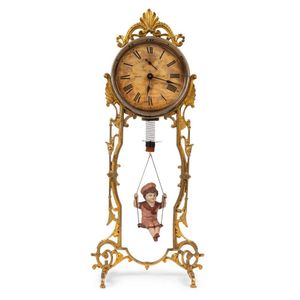Ansonia Jumper Doll Clock with Pink Porcelain Pendulum
You must be a subscriber, and be logged in to view price and dealer details.
Subscribe Now to view actual auction price for this item
When you subscribe, you have the option of setting the currency in which to display prices to $Au, $US, $NZ or Stg.
- Pendulum - The pendulum was discovered around 1602 by Galileo Galilei, and was adopted for time keeping by the Dutch mathematician and natural philosopher, Christiaan Huygens, who excelled in astronomy, physics, and horology.
The pendulum comprises a metal rod usually of brass or steel with a metal disk, known as a bob, at the end. The movement of the pendulum is driven by weights or a spring, and as a pendulum swings in a regular arc, it was found accuracy could be controlled to within a few seconds a week.
Timekeeping can be adjusted by changing the height of the bob on the rod, making the pendulum either swing slower or faster.
The disadvantage of the pendulum was that changes in temperature also changed the length of the pendulum, interfering with the accuracy of the clock, and so in the 18th century two types of mercurial pendulums were invented which countered the movement in the steel rod.
The pendulum was the world's most accurate timekeeping technology until the invention of the quartz clock, regulated by a quartz crystal, in 1927. - Circa - A Latin term meaning 'about', often used in the antique trade to give an approximate date for the piece, usually considered to be five years on either side of the circa year. Thus, circa 1900 means the piece was made about 1900, probably between 1895 and 1905. The expression is sometimes abbreviated to c.1900.
This item has been included into following indexes:
Visually similar items


Mamiya Camera Co. (Japan): Mamiya Super 16, c1949, early version marked 'Made in Occupied Japan' on back; in maker's leather case; a Mamiya-16 Automatic, c1959. Also, a Feinwerktechnik (Germany) Mec-16 sub-miniature camera (black with black leather) c1958,

Patek Philippe, an 18ct white gold wristwatch ref 3512 mvt 1131937 case 317204 made in 1965, Cal. 175 manual winding movement, fully jewelled, adjusted to heat, cold and 5 positions, stamped with the seal of Geneva, silvered dial with applied baton hour ma

Vintage Omega Seamaster calandar automatic watch gold plated with a stainless steel back, with an 18ct gold band, total weight approx 67 grams (working)
